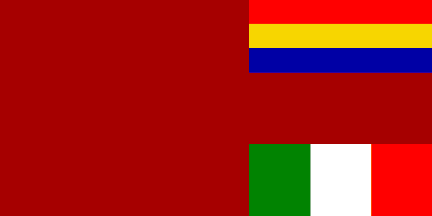
2 Febuary 1921 - 16 march 1924
by Ralf Stelter, 23 January 2001

Last modified: 2002-09-28 by dov gutterman
Keywords: italy | fiume | carnaro | rijeka | croatia |
Links: FOTW homepage |
search |
disclaimer and copyright |
write us |
mirrors

2 Febuary 1921 - 16 march 1924
by Ralf Stelter, 23 January 2001
See also:
Once again a flag showing the wide spread misunderstanding of
darkred/red colour shades. Above is the flag of Fiume is
"very precisely" described as "light violet
turning to magenta". I do not know the inventor of this
dubious description, but what IS known about that flag: it had
horizontal stripes of "karmesinrot-goldgelb-kobaltblau"
which is crimson (dark red)-golden yellow-cobalt blue",
"translated" into Pantone: ca. 193/200-116-300.
I do not know the status of the flag up to 1918, but if it was in
use then only as a city flag, I believe. The flag was official
from 2 feb 1921 to 16 march 1924, and there was a version with
arms.
As is written in the text below, the colours derive from the
arms. Who would believe that an Austro-Hungarian, resp. Italian
city of the 19th century will have other than heraldic colours in
their CoA?
Short history of Fiume:
Until Febuary 1867 - Austria, then Hungary,
28 October - 17 November 1918 - Yugoslav. Croatia,
17 November 1918 -12 September 1919 - Interallied occupation,
November 1920 (Treaty of Rapallo) - international recognition as
Free State,
12 January 1924 - Italy (Treaty of Rome),
1947 - Yugoslavia (peace at Paris).
Ralf Stelter, 23 January 200
Fiume's motto was "INDEFICIENTER" in Latin. Meaning
'Inexhaustible', as in non-deficient or never-deficient of water,
reffering to the source and the short river of Rjecina/Fiumara.
The first is Croatian, the latter is Italian name of the river
both giving the name of the city Rijeka/Fiume. The vase pouring
water in the CoA refers to the same.
Nozomi Kariyasu and Zeljko Heimer, 22 August
2002
Red-Yellow-Blue horizontal with shield or emblem
Jaume Olle' , 5 June 1997

by Jaume Olle' , 10 October 1998
Fiume, withouth austrian troops, was take by rebeld croatian
soldiers on 23 October 1918 and Croatian flag was hoisted. On 27
October it became under the control of the South Slavian Commitee
of Agram. On 4 November an Italian ship took the city and install
an Italian commitee, but a few days later an Interallied Commitee
was installed , and a french base was created. Several incidents
happended between Italian and French, and also between Italian
and Serbs. Yugoeslavia and Italia claimed the controll and this
dispute wasn't resolved in the Peace treaty of 2 September 1919.
The poet Gabriel d'Anunzio, with a italian corp of volunteers,
took the city on 12 September 1919 and create an independent
goverment called Italian Regency of Carnaro. Under Yugoeslavian
preasures Italia blocked the city, and finally the treaty of
Rapallo (12 Novemb